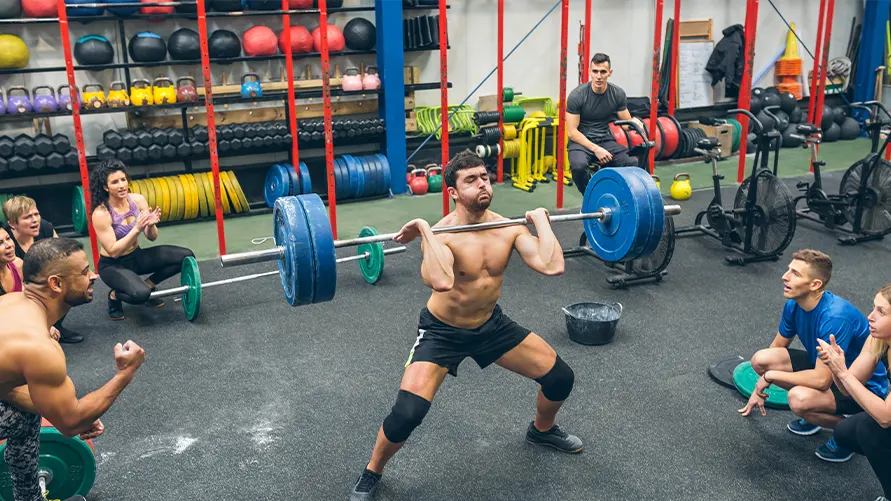To ensure the success of the business, it is essential for a business owner to understand the essential statistics. These statistics aid business owners in understanding what their target audience wants, essential information about their competition and the demographics of the audience to whom they are going to target. Thus, these statistics help the business owner to make data-driven decisions to ensure success of their business by increasing the number of clients using their products or services.
Similarly, the same concept is implemented in the fitness industry, which has seen tremendous growth in terms of revenue and members in the past few decades. It is essential for fitness business owners to understand the latest trends and key statistics related to the fitness industry. These statistics not only help them understand the target audience but also aid them in understanding what their target audience wants.
So, they can make data-driven decisions to ensure long-term success in the fitness industry by beating the competition. Otherwise, their competition becomes the market leader by attracting new members to their fitness centers. As a fitness business owner, you might be curious about the latest trends and stats in the fitness industry that can help you shape the future of your business in 2025. Look no further! We have done research on the fitness industry and gathered the most relevant statistics that enable you to stay ahead in the business. To aid you in understanding your members better, here are145+ fitness statistics that you need to know.
General fitness industry statistics
Before ensuring a remarkable fitness experience for your members, you have to understand what your target audience wants from your fitness center. So you can make data-driven decisions and program exercises in your studio according to your audience preferences. Here are some of the essential statistics of the fitness industry that can help you understand the valuation of the fitness industry, the demographics of members, and what motivates a member to join the fitness center.
What motivates a member to join a fitness center
Whenever a fitness business owner starts a fitness center, the first question that hits their mind is what drives the fitness freaks towards their fitness center. The answer to this question is provided by the research conducted by Statista, which is,
- 44% of the members join a fitness center to stay in shape.
- 42% of the audience says that they prefer fitness centers to maintain a healthy lifestyle.
- 34% of the fitness freaks join a fitness center to strengthen their muscles.
- 33% of the audience joins a fitness studio to lose weight.
- 32% of the members say they join a center to look good in appearance.
- 25% of the members start their fitness journey to have a thrilling experience.
- 31% of the fitness freaks join a fitness studio to have fun.
- 28% of the people say that they join fitness studios to meet new people.
- 28% of the fitness freaks join a gym to reduce stress.
Fitness industry revenue and number of studios
To excel in business, it is essential for the business owner to understand the overall valuation of that business and the number of competitors competing worldwide. As a fitness studio, it is also essential to understand the fitness industry’s valuation. So you can make data-driven decisions for long-term success.
Pre-pandemic era
- In 2019, The market valuation of the health and fitness industry was $96.7 billion. (Statista)
- The number of health clubs that operated around the globe in 2019 were around 205,000, accommodating 186.4 million members. (IHSRA)
- Fitness club memberships grew by 28% between 2013 and 2019. (Gitnux)
- The market capitalization of fitness studio software was 3.343 billion in 2017 and grew to 3.698 billion in 2019. (Statista)
- 1 out of 5 Americans had at least one fitness club membership in 2019. (IHSRA)
COVID-19 era
- Due to the outbreak of COVID-19, fitness and health clubs around the globe were forced to close in 2020.
- The closure of fitness and health clubs reduced the revenue of the industry from $96.7 billion in 2019 to $54.2 billion in 2021. (Wellness Creatives Co)
- The outbreak of COVID-19 reduced the revenue of the fitness industry by 44%. (Wellness Creatives Co)
- Health clubs in America lost around $13.9 billion between mid-March and August 31, 2020. (IHSRA)
Post-pandemic era
- After COVID-19, the fitness industry is expected to grow at 171.75%. (RunRepeat)
- The fitness industry generated a revenue of $216 billion globally in 2023. (RunRepeat)
- By 2028, the fitness industry is expected to reach a market valuation of $435 billion globally. (RunRepeat)
- After Corona, the 5000 more fitness clubs started to operate worldwide in 2021. (Wellness Creatives Co)
- Fitness studio software was valued at $16.88 billion in 2023 and is expected to reach a valuation of $38.05 billion by 2030. (Verified Market Research)
- In 2023, the revenue generated by the fitness industry in Europe was €28 billion. (RunRepeat)
- The number of members who attended fitness clubs in Europe in 2023 were 63.1 million. (RunRepeat)
- 30% of the fitness clubs that offer service to fitness freaks are located in Europe(Statista)
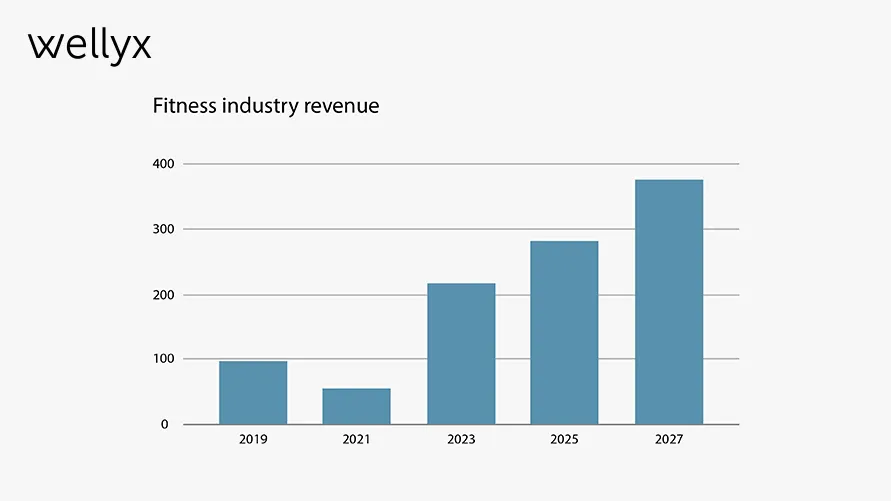
Fitness industry niches
As a studio owner, it is essential for you to understand the different niches of the fitness industry and the statistics related to it. This knowledge enables you to choose the niche in which you want to succeed and better understand your audience. Here are the top industry niches that enable you to make data-driven decisions for success.
Gym
A gym is a place that fitness freaks join to strengthen their physical strength and achieve mental peace. Thus, as a fitness studio owner, it is essential for you to understand the statistics related to the gym and what sort of exercises are preferred by the gym members. Here are the essential stats that fitness studios must know about the gym.
Gym statistics by age
- 31% of the fitness freaks that join the gym for physical fitness lies in the age bracket of 18–34 (IHSRA)
- Adults in the age bracket of 35–34 make up 31% of the population that join a gym for strength. (IHSRA)
- Gym Goers under the age bracket 55–64 and 65+ are less likely to join a gym, with a ratio of 10% and 12%. (IHSRA)
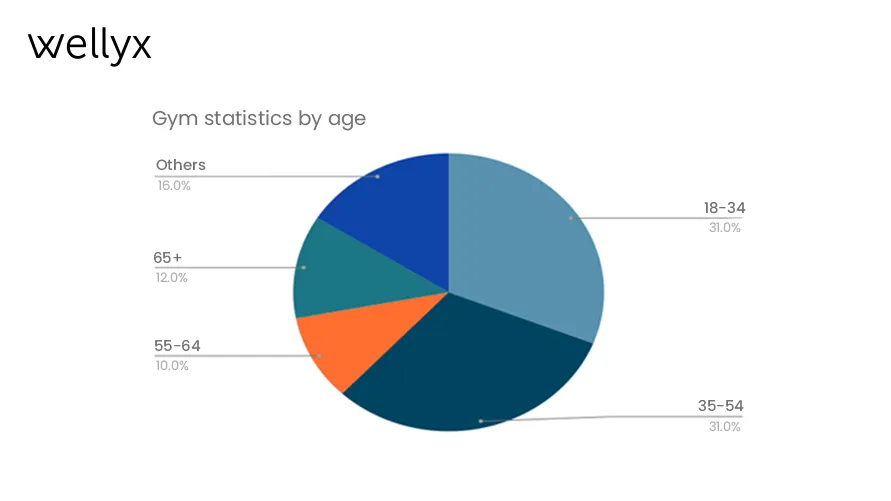
The following percentage of members under the age of 30 join a gym, as per Les Mills reports.
- The generation born between 1949 and 1963 makes up 6% of the members that join the gym.
- 14% of the share of gym goers is taken by Gen X born between 1964 and 1979.
- Millennials make up 45% of the fitness industry and were born between 1979 and 1993.
- The generation GenZ, which was born between 1994 and 2002, made up 35% of gym goers.
Gym statistics by gender
- Gym memberships worldwide are nearly equally distributed among men and women, who make up 49.5% and 50.5%, respectively. (IHSRA)
- From 2010 onwards, the ratio of female members in the gym has increased to 32.2%. (RunRepeat)
- The ratio of men who joined the gym after 2010 increased with a ratio of 23.2%. (RunRepeat)
- Women spend around 0.3 hours on exercise as compared to men, who spend 0.44 hours daily on exercise. (Statista)
- The ratio of men and women who quit gym memberships after a year is 8% and 14%. (Finances Online)
- 43% of the women and 46% of the men use mobile phones during workouts in the gym. (RunRepeat)
Gym statistics by race
As per RunRepeat research, here is the breakdown of gym-goers based on ethnicity or race.
- The African-American ratio in the gym is around 12.3%.
- The ratio of Asians going to the gym is around 7.19%
- White people make up 66.34% in gyms.
- Hispanics make up around 12.78%.
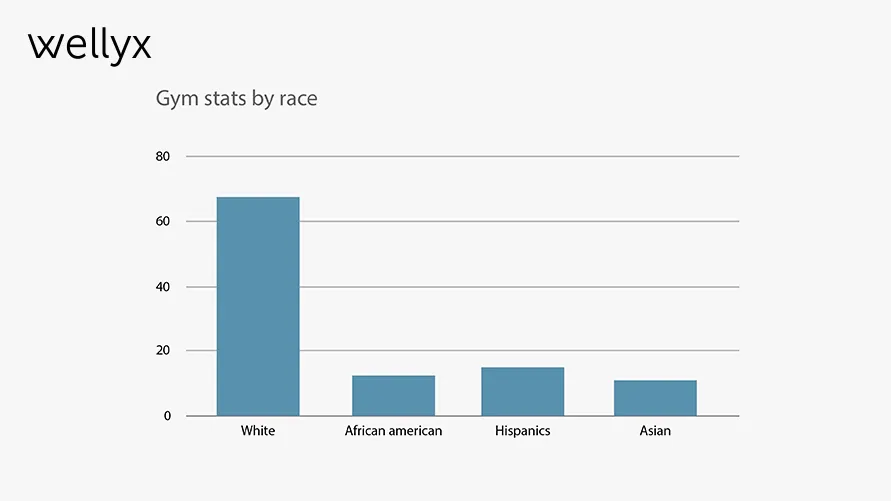
Gym attendance statistics
- In the US, the number of members that joined the gyms has increased by 27% and reached a number of 73.6 million since 2010. (IHSRA)
- 21% of gym members attend fitness classes on a daily basis. (Statista)
- Around 38% of the gym goers participate in multiple classes in a week. (Statista)
- 15% of the members attend the gym once a week. (Statista)
- 29% of the gym goers attend gym classes between 9 am and noon. (Statista)
- 20% of the members go to the gym between 2 pm and 5 pm. (Statista)
- 16% of gym goers attend classes between 8 pm and 11 pm. (Statista)
- 18% of members never attend a single class. (Statista)
- 12% of the members around the globe start their fitness journey in January. (IHSRA)
- 38% of the members go to the gym between 5 am and 9 am. (Statista)
Statistics on popular gym classes
As a fitness business owner, it is essential for you to have an understanding of the popular fitness classes. These statistical analyses aid you in boosting your studio growth. Moreover, knowledge about popular classes also aids you in defining a remarkable fitness experience for your members.
- Five million around the globe participate in CrossFit training worldwide. (CrossFit)
- People who perform CrossFit are equal in ratio, 50% men and 50% women. (CrossFit)
- The global market size of crossFit training was $4.5 billion in 2022. (LiveStrong)
- The minimum age to perform CrossFit training is 14 years. (LiveStrong)
- Boxing and martial arts market size was 9.05 billion in 2022. (LiveStrong)
- 73% of men participate in martial arts and boxing, while women participate in martial arts at around 27%. (LiveStrong)
- Participation in the age bracket 7-12 is around 26%, while the age bracket of 25 to 34 represents 21% of martial arts and boxing memberships. (LiveStrong)
- In the US, the number of people who participated in fitness bootcamp was approximately 5.43 million. (Statista)
- The bootcamp market size is expected to grow to 15.2% CAGR between 2022 to 2028. (Statista)
Yoga
As a fitness studio owner, it is essential for you to know about the statistics related to yoga. So, if the audience in your region wants yoga classes, you should start these classes without much effort. Moreover, these statistical analyses aid you in boosting your studio revenue by adding an additional stream in the form of yoga classes. Here are some essential statistics related to yoga that you must know.
Yoga statistics by age
- 37% of the yoga practitioners worldwide are under the age of 18. (LiveStrong)
- About 19% of practitioners lie in the age bracket of 18 and 29. (LiveStrong)
- 23% of the yoga practitioners are between the ages of 30 and 39. (LiveStrong)
- The ratio of practitioners between 40 and 49 is 20%. (LiveStrong)
- 17% of practitioners are between 50 and 59. (LiveStrong)
- 21% of the yoga practitioners are above 60+. (LiveStrong)
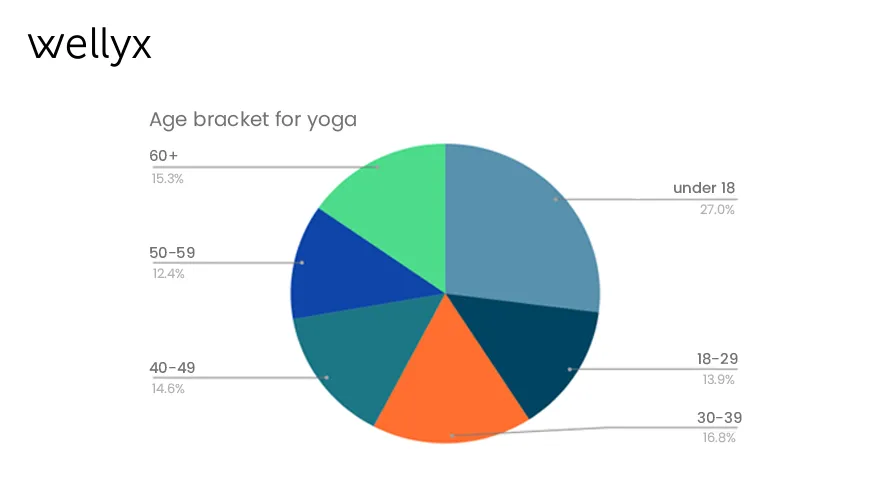
Yoga statistics by gender
- Around 72% of the women around the globe practice yoga. (LiveStrong)
- The ratio of men who practice yoga on a daily basis is around 28%. (LiveStrong)
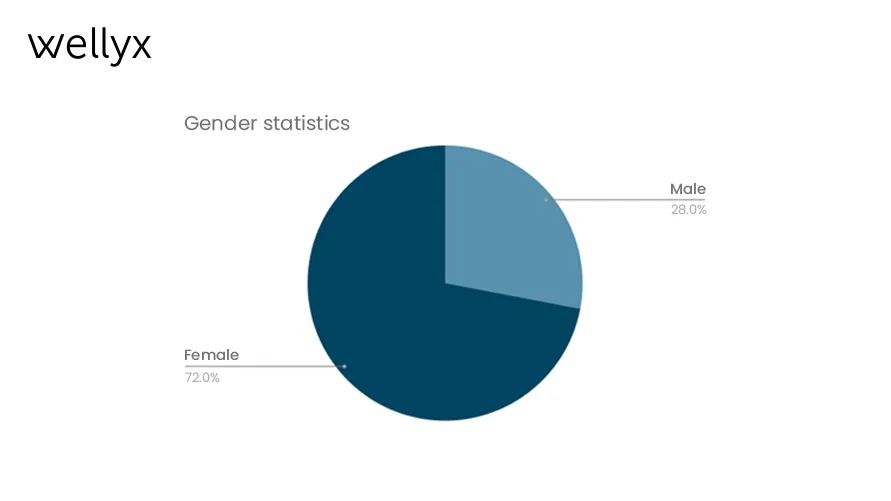
Yoga health statistics
As per Statista analysis, people around the globe perform yoga for:
- 61% of the people stated that they started performing yoga to improve their flexibility.
- To get rid of stress, 56% of people around the globe perform yoga.
- 49% of the people perform yoga to improve their overall health.
- 44% of the people stated they perform yoga to improve physical fitness.
- 80% of the yoga practitioners stated that they get a good body balance after starting yoga. (LiveStrong)
- 75% of the yogis stated that they feel strong after practicing yoga. (LiveStrong)
- 86% of the audience stated they get mental clarity after performing yoga. (LiveStrong)
- People who perform yoga are 20% more likely to have a positive image of mental health as compared to non-practitioners. (LiveStrong)
- 17.5% of practitioners around the globe perform yoga to strengthen specific health conditions. (National Center for Complementary and Integrative Health)
- 79% of the yogis also take part in other exercises such as running, cycling, or strength training. (LiveStrong)
Statistics about the type of yoga
- Around 800 types of yoga are practiced worldwide(Harvard Health Publishing)
As per HealthifyMe, the following are the most famous yoga types around the globe:
- Ashtanga yoga
- Hatha yoga
- Iyengar yoga
- Hot yoga
- Kundalini yoga
- Power yoga
- Restorative yoga
- Vinyasa yoga
Another report suggests that the following types of yoga are among the most popular calming and restorative workouts:
- Hot yoga
- Yin yoga
- Hatha yoga
- Ballet
- Reformer pilates
- Mat pilates
- Restorative yoga
As per the National Association Of Complementary and Alternative Medicine, there are 20 postures in Prenatal yoga:
- Bent knee
- Bridge pose
- Shoulder stretch
- Cat stretch pose
- Standing bent knee pose
- Backrest to wall
- Bent knee leg stretch
- Bent knee thigh stretch
- Straight leg stretch
- Standing straight leg stretch
- Hero’s pose
- Reclining Hero’s pose
- Sidle angle pose
- Triangle pose
- Squat to wall
- Butterfly pose
- Wide angle pose
- Bent knee twist
- Side-lying pose
Dance
Another niche of the fitness industry that a fitness owner like you should be aware of is the dance industry. Audiences around the globe join the dance studio to get the required flexibility with some enjoyment. So, it is essential for you to understand the required statistics related to the dance industry. If your audience wants to dance in your studio, it is necessary for you to have knowledge about the dance industry. Here are some statistics that you must know to understand your audience better.
Dancer’s statistics by age
- 51% of Americans over the age of 18 have attended at least one dance performance once in a lifetime. (World metrics)
- Basic training for ballet starts at the age of 3 to 4 years. (Youth Ballet)
- Some professionals start their ballet training at 11 or 13 years. (Youth Ballet)
- Professional ballet dancers stop practicing ballet dance between 35 and 40 years. (The National Ballet of Canada)
- The target audience that performs hip-hop dance lies between 17 and 36 years old. (EQOL Journal)
- The best age for kids to learn dancing is between 7 and 9 years old. (Stelle)
- The majority of professional dancers retire by the age of 35. (Forbes)
- 15% of children between 3 and 17 years in the United States participate in dance. (World metrics)
- 37% of Americans over the age of 18 visit ballet annually. (World metrics)
- Folk dancers lie in between the age bracket of 8 years to 35 years in the US. (American Youth Dances)
- Dancers above the age of 40+ make up 4% of the industry. (Zippia)
- 25% of the participants lie in the age bracket of 30–40 years old. (Zippia)
- 62%of the participants of the dance lie in the age bracket of 20-30 years. (Zippia)
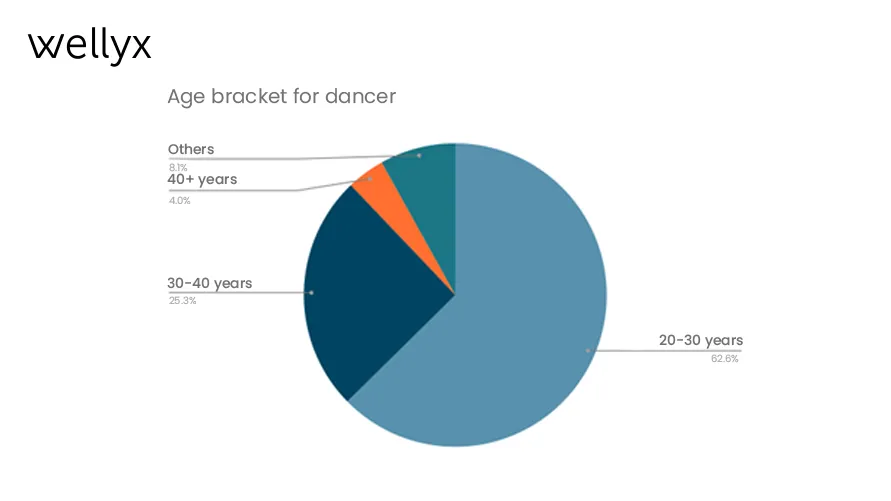
Dancer statistics by Gender
- The ratio of women across the globe in dance is 73.4%. (Zippia)
- 26.6% of men participate in dance worldwide. (Zippia)
- From 2010 to 2021, men’s participation in dance decreased from 34.70% to 26.6%. (Zippia).
- Women’s participation increased from 65.30% to 73.40% from 2010 to 2021. (Zippia)
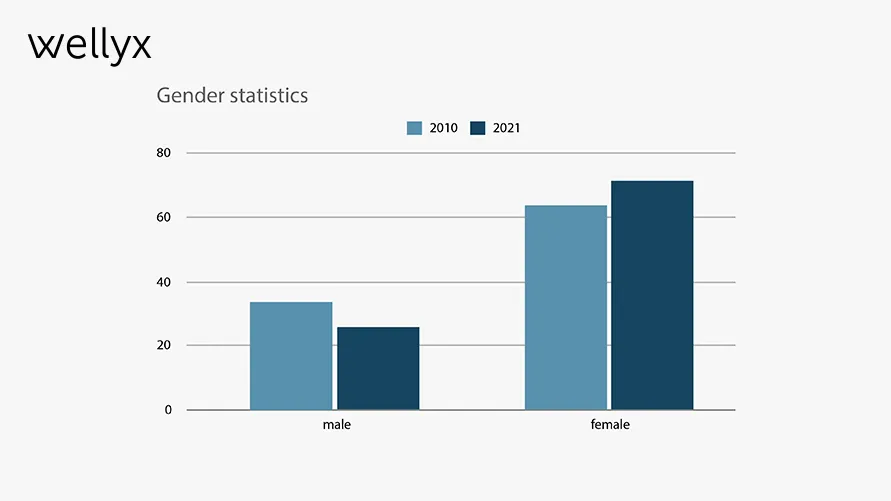
Dancer demographics by race
- 43.9% of the dancers in the dance industry are white. (Gitnux)
- Asian participation in the dance industry is about 8.4% (Gitnux)
- Latino make up 29.5% of the dance industry. (Zippia)
- African Americans participation is about 6.5%. (Zippia)
- American Indians make up 1% of the dance industry. (Gitnux)
- Others make 10% participation in the dance industry(Zippia)
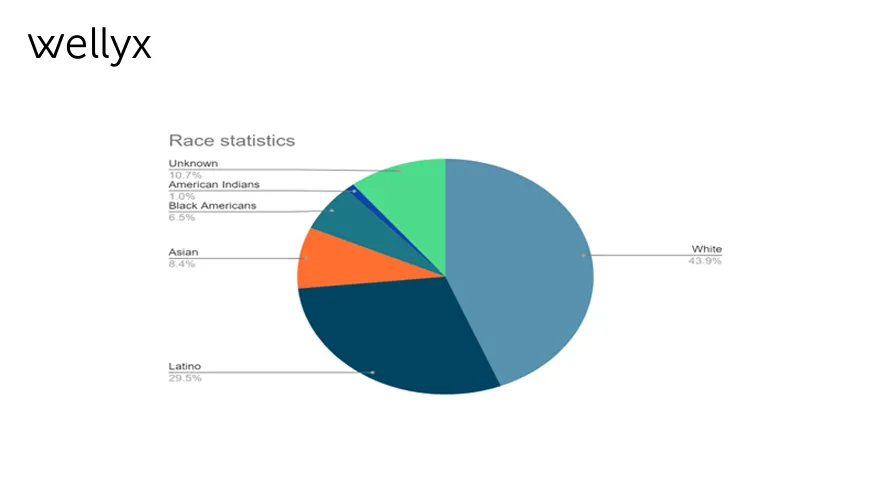
The future of the fitness industry: Stats of Virtual classes
- The virtual industry is expected to grow at 33.1% CAGR worldwide, expected to reach a market valuation of $59 billion by 2027. (Zippia)
As per Dacast, the top 5 live-streaming platforms for virtual classes in 2025 are:
- Livestream
- Cincopa
- Zoom
- Google Meet
- Muvi
- In 2022, virtual fitness classes make up the 9 spot in the top 10 trends of the fitness industry. (Wellness Creatives Co)
As per Finance Online, here are the top three courses that are popular virtually worldwide.
- Pilates make up 8.30% of the virtual fitness classes.
- HIIT has a participation of 15.6%.
- Yoga participation is about 32%.
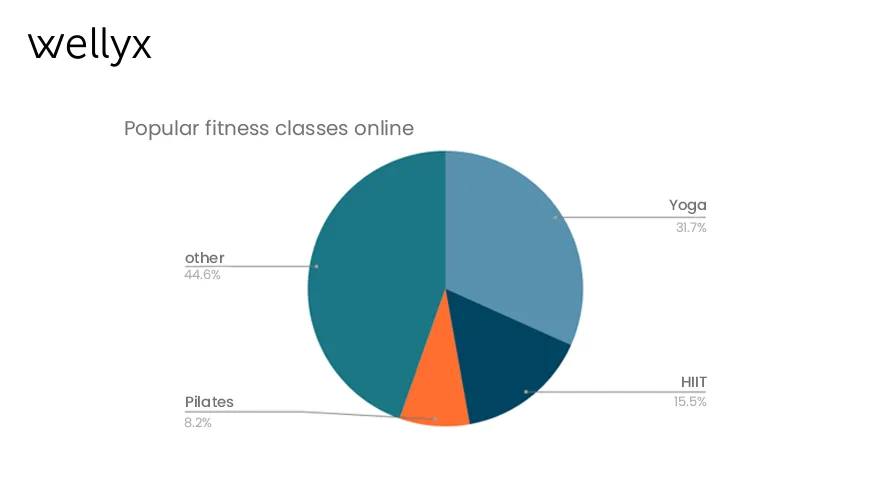
Final thoughts!
To ensure the success of your fitness studio, it is essential for you to make data-driven decisions. This will help you attract new members by ensuring a remarkable fitness experience for them. It will also aid you in the financial stability of your fitness center and enable you to expand your business.
Understanding the essential stats about the fitness industry, such as preferences and demographics, is essential for data-driven decisions. This will give you a competitive edge over your competition for long-term success.
